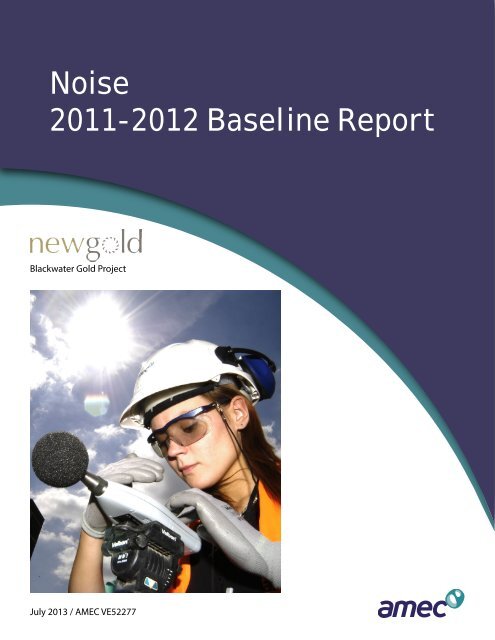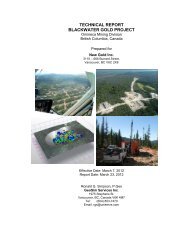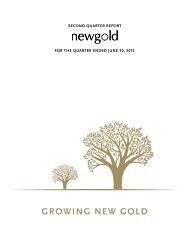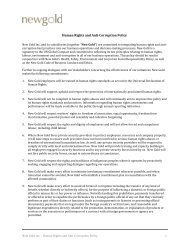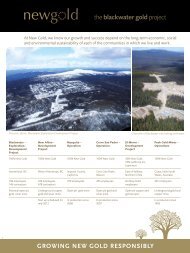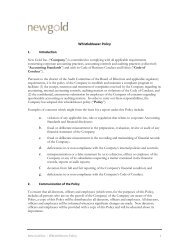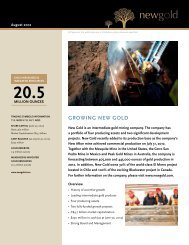BACKGROUND NOISE - New Gold
BACKGROUND NOISE - New Gold
BACKGROUND NOISE - New Gold
Create successful ePaper yourself
Turn your PDF publications into a flip-book with our unique Google optimized e-Paper software.
Noise<br />
2011-2012 Baseline Report<br />
Blackwater <strong>Gold</strong> Project<br />
July 2013 / AMEC VE52277
Blackwater <strong>Gold</strong> Project<br />
Noise<br />
2011-2012 Baseline Report<br />
Prepared for:<br />
<strong>New</strong> <strong>Gold</strong> Inc.<br />
Suite 3110 – 666 Burrard Street<br />
Vancouver, BC V6C 2X8<br />
Prepared by:<br />
AMEC Environment & Infrastructure<br />
a division of AMEC Americas Ltd.<br />
Suite 600, 4445 Lougheed Hwy<br />
Burnaby, BC V5C 5A9<br />
AMEC File: VE52277<br />
June 2013<br />
Version 4.0
BLACKWATER GOLD PROJECT<br />
BASELINE REPORT<br />
<strong>NOISE</strong><br />
TABLE OF CONTENTS<br />
ACRONYMS ............................................................................................................................................ I<br />
EXECUTIVE SUMMARY ........................................................................................................................ II<br />
1.0 INTRODUCTION ....................................................................................................................... 1<br />
1.1 Fundamentals of Environmental Acoustics .................................................................. 1<br />
1.1.1 Sound Intensity ................................................................................................ 2<br />
1.1.2 Sound Frequency Spectrum ............................................................................ 3<br />
1.1.3 Time-Varying Character of Sound ................................................................... 4<br />
1.2 Scope of Work .............................................................................................................. 5<br />
1.3 Objectives ..................................................................................................................... 5<br />
2.0 METHODS ................................................................................................................................. 6<br />
2.1 Information Sources ..................................................................................................... 6<br />
2.2 Methods for Data Collection and Data Analysis ........................................................... 8<br />
3.0 RESULTS/DISCUSSION .......................................................................................................... 9<br />
4.0 CONCLUSIONS ...................................................................................................................... 11<br />
REFERENCES ..................................................................................................................................... 12<br />
List of Tables<br />
Table 1.1-1: Range of Typical Noise Levels ..................................................................................... 2<br />
Table 3.1-1: Baseline Sound Parameters for Blackwater <strong>Gold</strong> Project and for Reference<br />
Projects ....................................................................................................................... 10<br />
List of Figures<br />
Figure 2.1-1: Location of Baseline Noise Projects and Regional Topography .................................. 7<br />
Version 4.0<br />
VE52277 - Baseline Report June 2013<br />
TOC i
BLACKWATER GOLD PROJECT<br />
BASELINE REPORT<br />
<strong>NOISE</strong><br />
ACRONYMS<br />
Abbreviations and<br />
Units of Measure<br />
AMEC<br />
ANSI<br />
Application<br />
BC<br />
BC EAA<br />
cps<br />
dBA<br />
AMEC Environment & Infrastructure<br />
Definition<br />
American National Standard Institute<br />
Application for an Environmental Assessment Certificate<br />
British Columbia<br />
British Columbia Environmental Assessment Act<br />
cycle per second<br />
decibel A-scale<br />
°C degrees Celsius<br />
EA<br />
Hz<br />
ISO<br />
km<br />
km/hr<br />
L 10<br />
L 50<br />
L 90<br />
L eq<br />
L eq D<br />
L eq N<br />
Environmental Assessment<br />
Hertz<br />
International Organization for Standardization<br />
kilometre<br />
kilometre per hour<br />
sound level equalled or exceeded 10% of the measurement time<br />
sound level equalled or exceeded 50% of the measurement time<br />
sound level equalled or exceeded 90% of the measurement time<br />
equivalent sound pressure level<br />
day average sound pressure level<br />
night average sound pressure level<br />
log logarithm base 10<br />
m<br />
masl<br />
m/s<br />
metre<br />
% percent<br />
PNL<br />
PSL<br />
proposed Project<br />
SPL<br />
US EPA<br />
UTM<br />
metres above sea level<br />
metres per second<br />
perceived noise level<br />
permissible sound level<br />
proposed Blackwater <strong>Gold</strong> Project<br />
sound pressure level<br />
United States Environmental Protection Agency<br />
Universal Transverse Mercator<br />
Version 4.0<br />
VE52277 - Baseline Report June 2013<br />
Page I
BLACKWATER GOLD PROJECT<br />
BASELINE REPORT<br />
<strong>NOISE</strong><br />
EXECUTIVE SUMMARY<br />
Baseline noise levels were estimated to characterize the acoustical environment at the<br />
proposed Blackwater <strong>Gold</strong> Project (the Project) site in preparation for the Application for an<br />
Environmental Assessment Certificate (Application) under the British Columbia<br />
Environmental Assessment Act (BC EAA). Specific objectives of the noise baseline<br />
programs were to find equivalent sound pressure levels (SPL) and sound statistical<br />
descriptors that existed at remote locations of the Project prior to commencement of the<br />
exploratory, construction, and operation activities.<br />
AMEC Environment & Infrastructure (AMEC) completed the baseline sound monitoring<br />
surveys in central British Columbia (BC) in connection with the mining projects that included<br />
Hillsborough Echo Hill Coal, Mt. Milligan Copper-<strong>Gold</strong>, and Bullmoose North Coal. The<br />
results were gathered and statistically analyzed in a desktop study, and were used as the<br />
pre-exploration and pre-construction natural sound levels representing undisturbed acoustic<br />
environment of the Project site. The estimated baseline equivalent sound pressure levels<br />
were approximately 30 decibels (dBA), with almost no difference between daytime (30 dBA)<br />
and night time (29 dBA) levels.<br />
A background noise will be added to the predicted construction and operation noise and the<br />
resulting cumulative values compared to permissible sound levels (PSL). In addition, spatial<br />
distribution of cumulative noise levels will be presented in a noise impact assessment report<br />
to show the noise contours characterizing noise attenuation from the highest to the<br />
background levels.<br />
Version 4.0<br />
VE52277 - Baseline Report June 2013<br />
Page II
BLACKWATER GOLD PROJECT<br />
BASELINE REPORT<br />
<strong>NOISE</strong><br />
1.0 INTRODUCTION<br />
Knowledge of a baseline noise level is a prerequisite to undertaking the Environmental<br />
Assessment (EA) for the proposed Blackwater <strong>Gold</strong> Project (proposed Project). Noise levels<br />
during mining will be incremental to the existing background noise. The baseline noise<br />
strength is also important for assessing the perception of sound because a person’s<br />
subjective reaction is to compare the new noise environment to the undisturbed acoustic<br />
environment.<br />
In recent years, AMEC Environment & Infrastructure (AMEC) conducted environmental<br />
noise surveys in pristine areas in central British Columbia (BC) for the proposed mining<br />
projects as a component of EA. The results are showing similar baseline sound parameters<br />
at all monitored sites. This can be attributed to absence of the anthropogenic noise sources<br />
at these remote sites with only natural noise sources present such as wind blowing through<br />
trees, wildlife, birdsongs, distant thunder, insects, etc. The Project is also located in remote<br />
areas with comparable topography, regional climate, and ground cover, and away from<br />
regional municipal and industrial centers such as Prince George and Vanderhoof. Average<br />
values of baseline sound parameters recorded at three surveyed locations were calculated<br />
and accepted as baseline noise for the Project as described in the following sections.<br />
1.1 Fundamentals of Environmental Acoustics<br />
To better understand the noise potential issues in all stages of the Project lifetime, it is<br />
necessary to present a brief introduction to environmental acoustics.<br />
Sound is mechanical energy transmitted by pressure waves through a medium, such as air.<br />
Physically, there is no distinction between sound and noise: sound is a sensory perception<br />
evoked by physiological processes in the auditory brain. The complex pattern of sound<br />
waves is perceptually labelled as noise, music, speech, etc. It is not possible to define noise<br />
exclusively on the basis of the physical parameters of sound. Instead, it is common practice<br />
to define noise simply as unwanted sound. Consequently, sound and noise terms are often<br />
used alternatively.<br />
Three aspects of environmental sound are important in determining subjective response. :<br />
1. The intensity or level of the sound;<br />
2. The frequency spectrum of the sound; and<br />
3. The time-varying character of the sound.<br />
These aspects are described in the following subsections.<br />
Version 4.0<br />
VE52277 - Baseline Report June 2013<br />
Page 1
BLACKWATER GOLD PROJECT<br />
BASELINE REPORT<br />
<strong>NOISE</strong><br />
1.1.1 Sound Intensity<br />
Several noise measurement scales are used to describe the intensity or level of the sound in<br />
a particular location. The most common is the A-weighted sound level expressed in the A-<br />
scale decibel (dBA) unit. The A-scale gives greater weight to the frequencies of sound to<br />
which the human ear is most sensitive.<br />
There is a relationship between the subjective noisiness or loudness of a sound and its<br />
intensity. Each 10 dBA increase in sound pressure level (SPL) is perceived as about a<br />
doubling of loudness over a fairly wide range of intensities (Bell 1994). The decibel scale<br />
and typical examples of corresponding noise sources are shown in Table 1.1-1.<br />
Table 1.1-1:<br />
Range of Typical Noise Levels<br />
Sound Pressure Level<br />
(rounded in dBA)<br />
Typical Source<br />
Subjective Evaluation<br />
130 (Threshold of pain) Blasting Extremely noisy -<br />
120 Jet take-off<br />
intolerable<br />
110 Rock concert<br />
100 Pneumatic hammer Very noisy<br />
90 Heavy truck<br />
Loud shout<br />
80 Highway traffic Loud<br />
70 Loud radio or television<br />
Noisy restaurant<br />
60 Department store Moderate to quiet<br />
50 General office<br />
Quiet street<br />
40 Living room<br />
Library<br />
30 Bedroom<br />
Country site<br />
20 Unoccupied recording studio<br />
Remote underdeveloped area<br />
< 10 (Threshold of hearing) Anechoic chamber Silent<br />
Note: dBA = decibel A-scale<br />
Quiet to very quiet<br />
Almost silent<br />
The sound level of 0 dBA corresponds roughly to the threshold of hearing. The sound level<br />
of a quiet countryside during a quiet night is approximately 20 dBA, whereas a calm<br />
environment has sound levels between 30 and 50 dBA. Above 70 dBA, sounds become<br />
very disruptive (ISO 1969; US EPA 1974). Construction sources, e.g., pneumatic hammers,<br />
produce noise levels around 100 dBA.<br />
Version 4.0<br />
VE52277 - Baseline Report June 2013<br />
Page 2
BLACKWATER GOLD PROJECT<br />
BASELINE REPORT<br />
<strong>NOISE</strong><br />
With regard to increases in noise level, the following relationships can be helpful in<br />
understanding the quantitative changes in noise levels with reference to the public’s<br />
perception (Cowan 1994):<br />
<br />
<br />
<br />
<br />
Except in carefully controlled laboratory experiments, a change of only 1 dBA in<br />
sound level cannot be perceived;<br />
A 3 dBA change is considered a just-noticeable difference;<br />
A change in level of at least 5 dBA is required before any noticeable change in<br />
community response would be expected; and<br />
A 10 dBA change is subjectively heard as approximately a doubling in loudness, and<br />
would almost certainly cause an adverse community response.<br />
The measurement of sound level with standard instruments equipped with an A-weighting<br />
filter results in a de-emphasis of the very low and very high frequency components of sound<br />
in a manner similar to the frequency response of the human ear. This correlates well with<br />
subjective reactions to noise. All sound levels in this report are A-weighted, unless indicated<br />
otherwise.<br />
1.1.2 Sound Frequency Spectrum<br />
The frequency of a sound refers to the number of complete pressure fluctuations per second<br />
in the sound waves. The unit of measurement is the cycle per second (cps) or Hertz (Hz).<br />
Most of the sounds in the environment do not consist of a single frequency, but of a broad<br />
band of frequencies, differing in level. The name of the frequency and level content of a<br />
sound is its sound spectrum. A sound spectrum is typically described in terms of 1/3 or<br />
1/1 octave bands, which separate the audible frequency range (for human beings, from<br />
about 20 to 20,000 Hz) into 10 segments.<br />
The rate of sound propagation is frequency-dependent. Attenuations in air and other media<br />
are greater for low frequency noise than for infrasound. Typical air attenuations at<br />
20 degrees Celcius (ºC) and 70 percent (%) relative humidity are as follows:<br />
Frequency (Hz) 31.5 63 125 250 500 1,000 2,000 4,000 8,000<br />
Attenuation (dB per 1 km) 0.0 0.1 0.3 1.0 2.7 5.4 9.7 23.2 74.8<br />
The above shows no attenuation at low frequencies (e.g., 31.5 Hz and very little at 63 Hz).<br />
Air attenuations are a small contributor to losses at low frequencies, but because<br />
attenuation increases rapidly as frequency rises, air attenuation can be a main contributor to<br />
noise dissipation at much higher frequencies. As a result, noise, which has traveled over<br />
long distances, is normally biased towards the low frequencies (e.g., long wavelengths).<br />
The presence of a prevailing, specific, discrete frequency in the broadband noise results in a<br />
perception of noise loudness and noise character such as a rumble, roar, or hiss. Individual<br />
Version 4.0<br />
VE52277 - Baseline Report June 2013<br />
Page 3
BLACKWATER GOLD PROJECT<br />
BASELINE REPORT<br />
<strong>NOISE</strong><br />
octave band noisiness estimates are combined to give an overall perceived noise level<br />
(PNL) that is intended to estimate accurately the subjective evaluations of the same sound.<br />
PNL values will vary with time (e.g., when an aircraft flies by a measuring point). The<br />
frequency spectrum values add a duration correction and a tone correction to PNL values.<br />
The duration correction ensures that longer duration events are rated as more disturbing.<br />
Similarly, noise spectra that seem to have prominent tonal components are rated as more<br />
disturbing by the tone correction procedure.<br />
Most environmental noise is a conglomeration of distant noise sources that results in a<br />
relatively steady background noise having no identifiable source. These distant sources may<br />
include aircrafts, industrial activities, wind in trees and bushes, insects, amphibians, running<br />
water, birds, and animal noise, etc. and are relatively constant from moment to moment. As<br />
natural forces change or as human activity follows its daily cycle, the sound level may vary<br />
slowly from hour to hour. Superimposed on this slowly varying background is a succession<br />
of identifiable noisy events of brief duration. These may include nearby activities such as a<br />
single helicopter or aircraft flyover or snowmobile operation, which cause the environmental<br />
noise level to vary from instant to instant. In undisturbed remote areas, the anthropogenic<br />
noise sources are absent.<br />
1.1.3 Time-Varying Character of Sound<br />
Many environmental noises vary over time, such as for different times of day or from season<br />
to season. For example, service road traffic noise may be considerably louder during some<br />
hours of the day and much quieter at night. Aircraft noise may vary with the season due to<br />
different numbers of aircraft operations. It is usually not possible to measure SPLs<br />
continuously over a long enough period of time to completely define the environmental noise<br />
exposure. In practice, measurements usually only sample some part of the total exposure.<br />
To describe the time-varying character of environmental noise, statistical noise descriptors<br />
were developed. L 10 is the A-weighted sound level equalled or exceeded during only 10% of<br />
the measurement time. The L 10 provides a good measure of the maximum sound levels<br />
caused by intermittent or intrusive noise. L 50 is the A-weighted sound level that is equalled or<br />
exceeded 50% of the measurement time period; it represents the median sound level. L 90 is<br />
the A-weighted sound level equalled or exceeded 90% of the time. Since this represents<br />
'most' of the time, L 90 generally has been adopted as a good measure of the ambient<br />
baseline noise of the measurement site. Therefore, the baseline noise is defined as L 90 of<br />
the overall background noise.<br />
Because sound levels can vary markedly over a short period of time, a method for<br />
describing the average character of the sound must be utilized. Most commonly,<br />
environmental sounds are described in terms of an average level that has the same<br />
acoustical energy as the summation of all the time-varying events. This energy equivalent<br />
sound/noise descriptor is referred to as equivalent sound pressure level denoted by L eq . The<br />
most common averaging period is hourly; however, L eq can describe any series of noise<br />
Version 4.0<br />
VE52277 - Baseline Report June 2013<br />
Page 4
BLACKWATER GOLD PROJECT<br />
BASELINE REPORT<br />
<strong>NOISE</strong><br />
events for any selected duration such as daytime (7 a.m. to 10 p.m.), night time (10 p.m. to<br />
7 a.m.) or 24-hour duration. The L eq is particularly useful in describing the subjective sound<br />
change in an environment where the source of sound remains the same and the level of<br />
activity changes (Passchier 2000).<br />
In determining the daily measure of environmental noise, it is important to account for the<br />
different response of people to daytime and night time noise. During the night time, exterior<br />
background noise levels are generally lower than in the daytime; however, most household<br />
noise also decreases at night, thus exterior noise intrusions again become noticeable.<br />
Furthermore, most people trying to sleep at night are more sensitive to noise. To account for<br />
human sensitivity to night time noise levels, a special descriptor was developed. The<br />
descriptor is referred to as the Day/Night Average Sound Level (L eq D /L eq N ).<br />
1.2 Scope of Work<br />
Based on completed baseline noise surveys at similar undisturbed sites considered for<br />
mining projects in central BC, a desktop study was completed to establish likely background<br />
sound parameters for the Project site including:<br />
Equivalent SPL (L eq );<br />
<br />
Sound statistical descriptors (L 10 , L 50 , L 90 ); and<br />
Baseline SPLs for daytime (L 90 D ), night time (L 90 N ), and 24-hour (L 90 ).<br />
All sound units are given in the A-scale decibels.<br />
1.3 Objectives<br />
The overall objective of assessing the baseline noise was to characterize the acoustical<br />
environment at the Project site in preparation for the Application for an Environmental<br />
Assessment Certificate (Application) under the BC Environmental Assessment Act<br />
(Government of BC 2002) (BC EAA). A specific objective of the noise baseline program was<br />
to find equivalent SPLs and sound statistical descriptors that existed at the remote Project<br />
site prior to commencement of the exploratory, construction, and operations activities.<br />
Version 4.0<br />
VE52277 - Baseline Report June 2013<br />
Page 5
BLACKWATER GOLD PROJECT<br />
BASELINE REPORT<br />
<strong>NOISE</strong><br />
2.0 METHODS<br />
2.1 Information Sources<br />
Results of previously completed background noise surveys at three relevant sites in BC<br />
have been published in EA reports or are available at AMEC prior to publication in<br />
anticipated EA reports. The following projects have been used as references for the Project<br />
background noise estimate:<br />
Hillsborough Echo Hill Coal Project (AMEC 2013);<br />
<br />
Mt. Milligan Copper-<strong>Gold</strong> Project (AMEC 2008); and<br />
Bullmoose North Coal Mine Project (AMEC 2012).<br />
Their locations and the regional topography are shown in Figure 2.1-1.<br />
Detailed records of background noise surveys are available at the AMEC Burnaby office.<br />
Version 4.0<br />
VE52277 - Baseline Report June 2013<br />
Page 6
280000<br />
320000<br />
360000<br />
400000<br />
440000<br />
480000<br />
520000<br />
560000<br />
600000<br />
640000<br />
Legend<br />
6160000<br />
97<br />
6160000<br />
16<br />
Projects<br />
Populated Place<br />
Highway<br />
97<br />
Echo Hill<br />
29<br />
52<br />
6120000<br />
Mt Milligan<br />
39<br />
Bullmoose<br />
6080000<br />
6120000<br />
6080000<br />
118<br />
6040000<br />
Fort St. James<br />
6040000<br />
Burns Lake<br />
97<br />
27<br />
6000000<br />
35<br />
Fraser Lake<br />
Engen<br />
Vanderhoof<br />
6000000<br />
Y:\GIS\Projects\VE\VE52095_Richfield_Blackwater\Mapping\12_noise\Baseline\12-100-002_Noise_projects.mxd<br />
5960000<br />
5920000<br />
5880000<br />
280000<br />
320000<br />
360000<br />
Blackwater<br />
<strong>Gold</strong> project<br />
400000<br />
440000<br />
16<br />
480000<br />
Prince George<br />
97<br />
520000<br />
Quesnel<br />
560000<br />
26<br />
600000<br />
16<br />
640000<br />
5960000<br />
5920000<br />
5880000<br />
Reference<br />
BC Government GeoBC Data Distribution<br />
CLIENT:<br />
PROJECT:<br />
DATE:<br />
JOB No:<br />
March, 2013<br />
VE52095<br />
PROJECTION:<br />
UTM Zone 10<br />
ANALYST:<br />
MY<br />
GIS FILE:<br />
12-100-002_Noise_projects.mxd<br />
Scale:1:1,300,000<br />
0 5 10 20 30 40 50<br />
Blackwater <strong>Gold</strong> Project<br />
Baseline Noise Sites<br />
QA/QC:<br />
AP<br />
DATUM:<br />
NAD83<br />
Kilometres<br />
PDF FILE:<br />
12-100-002_Noise_projects.pdf
BLACKWATER GOLD PROJECT<br />
BASELINE REPORT<br />
<strong>NOISE</strong><br />
2.2 Methods for Data Collection and Data Analysis<br />
In recent years, background noise surveys have been conducted by AMEC in remote areas<br />
in central BC for proposed mining projects. Analysis of the results revealed that the<br />
measured sound parameters are comparable, although not identical. The similarity in<br />
baseline noise levels can be explained by absence of anthropogenic noise sources,<br />
comparable topography, similar ground cover, and sufficient proximity of sites to have<br />
similar wildlife. These factors influence the acoustic environment, likely dominated by noise<br />
generated by various sources such as wind blowing through trees and vegetation, wildlife,<br />
birdsongs, animal and amphibian calls, the sound of running water near streams, insects,<br />
etc.<br />
The differences in sound parameters between surveyed sites are insignificant when referred<br />
to the perception of changes in noise levels discussed in Section 2.1 above (Cowan, 1994).<br />
However, it must be realized that baseline noise levels at a specific site can change<br />
significantly with time of the day/night, season (quiet in winter), atmospheric conditions (high<br />
levels during windy weather and thunderstorms), and accidental anthropogenic sources<br />
(plane or helicopter flyover, logging activities). Therefore, baseline noise levels are usually<br />
understood as inexact values within some unpredictable maximum – minimum range.<br />
Baseline noise levels for all three referred projects were obtained by a direct 24-hour<br />
continuous monitoring carried out in accordance with the following guidelines:<br />
<br />
<br />
American National Standard Institute (ANSI) 1994: Procedures for Outdoor<br />
Measurement of Sound Pressure Level (ANSI 1994);<br />
International Organization for Standardization (ISO) 2005: Acoustics - Description,<br />
Assessment and Measurement of Environmental Noise. Part 2: Determination of<br />
Environmental Noise Levels (ISO 2005); and<br />
British Columbia Noise Control Best Practices Guideline (BC Oil & Gas 2009).<br />
The following baseline noise survey requirements potentially affecting the monitoring results<br />
were fulfilled at each site:<br />
Meteorological parameters: wind speed below 4 metres per second (m/s) (14.4<br />
kilometres per hour (km/hr)), no precipitation, relative humidity below 95%,<br />
temperatures below the freezing point;<br />
<br />
<br />
<br />
Similar ground cover (forest, trees, bushes, shrubs, grass);<br />
Complex terrain (mountainous areas, elevations 900 to 1,100 metres above sea level<br />
(masl)); and<br />
Instrumentation: sound level meters Type 2 with the current versions of ANSI S1.4-<br />
1971 and ANSI S1.11-1966 standards and on-site calibrators.<br />
Version 4.0<br />
VE52277 - Baseline Report June 2013<br />
Page 8
BLACKWATER GOLD PROJECT<br />
BASELINE REPORT<br />
<strong>NOISE</strong><br />
3.0 RESULTS/DISCUSSION<br />
Baseline noise levels at the Project site were estimated by calculating logarithmic means of<br />
measured sound parameters of the referred projects. A logarithmic mean, unlike an<br />
arithmetic mean, tends to dampen the effect of low values, which might bias the mean if a<br />
straight average (arithmetic mean) is calculated.<br />
The logarithmic means of sound parameters were calculated using the following formula:<br />
L eq = 10 × log {1/n Σ 10 (Li/10) }<br />
where:<br />
L eq is the sound parameter in dBA calculated for the Project, e.g., equivalent<br />
sound pressure level L eq.<br />
n is the number of referred baseline noise data sets (equals to 5 as shown in<br />
Table 3.1-1).<br />
Li is a corresponding sound parameter for each referred project,<br />
e.g., equivalent sound pressure level L eq.<br />
A record of baseline survey results of referred projects and calculated sound parameters for<br />
the Project are shown in Table 3.1-1.<br />
Table 3.1-1 shows sound parameters continuously recorded during 24-hour surveys varied<br />
by approximately less than 5 dBA. This is expected due to some differences between the<br />
monitored sites and constantly changing environmental sound levels (refer to Section 2.2).<br />
A survey conducted at Mt. Milligan Copper-<strong>Gold</strong> Project site showed considerable lower<br />
sound levels as compared to other projects. This can be attributed to the survey time, which<br />
was in mid-October. Approaching winter with temperatures near the freezing point probably<br />
caused the disappearance of natural noise sources such as birds, insects, and amphibians<br />
from the monitored acoustic environment.<br />
The average sound parameters representing the Project baseline noise includes 24-hour<br />
equivalent (L eq ) SPL of 32 dBA, the median sound level (L 50 ) of 30 dBA and background<br />
sound (L 90 ) of 29 dBA. Daytime background SPL (L 90 D ) is estimated to be 30 dBA and night<br />
time SPL (L 90 N ) is 29 dBA. A small difference between these values indicates the acoustic<br />
environment free of rapid noise changes and lack of predominant frequencies in noise<br />
spectrum, which would result in a wider range of noise levels.<br />
Estimated baseline sound levels are more conservative than default values accepted in BC<br />
by the BC Oil & Gas Commission (2009), which for the rural areas are 35 dBA at night and<br />
45 dBA during the day. The daytime increase is due to the increase in wind sounds, animal<br />
sounds, and the remote sounds of human activities, mainly related to farming, forest<br />
management, and highway/service road traffic.<br />
Version 4.0<br />
VE52277 - Baseline Report June 2013<br />
Page 9
BLACKWATER GOLD PROJECT<br />
BASELINE REPORT<br />
<strong>NOISE</strong><br />
Table 3.1-1:<br />
Baseline Sound Parameters for Blackwater <strong>Gold</strong> Project and for Reference Projects<br />
Project<br />
UTM Location<br />
Sound Parameters (dBA)<br />
Elevation Sound Meter<br />
m E m N (masl)<br />
Type<br />
Survey Date L eq L 10 L 50 L 90 L 90 D L 90 N<br />
Hillsborough Echo Hill Coal 639252 6138094 889 Quest 2900<br />
2011 Aug 18-19 27.8 29.9 24.4 24.3 25.3 27.7<br />
2011 Aug 19-20 32.2 34.5 29.3 28.6 29.4 26.6<br />
2011 Aug 25-26 33.6 36.0 27.1 27.3 28.3 25.3<br />
Mt. Milligan Copper-<strong>Gold</strong> 436322 6107600 1056 Larson Davis 2006 Oct 12-13 21.7 25.1 19.2 17.1 16.6 17.8<br />
Bullmoose North Coal 600929 6118813 1092 Quest SE/DL 2012 Aug 14-15 36.1 38.1 34.9 34.5 34.4 34.6<br />
Blackwater <strong>Gold</strong> 375400 5893000 1602 n/a n/a 32.4 34.6 29.8 29.4 29.7 29.4<br />
Note:<br />
dBA = decibel A-scale; m = metre; masl = metres above sea level; n/a = not applicable; UTM = Universal Transverse Mercator<br />
Version 4.0<br />
VE52277 - Baseline Report June 2013<br />
Page 10
BLACKWATER GOLD PROJECT<br />
BASELINE REPORT<br />
<strong>NOISE</strong><br />
4.0 CONCLUSIONS<br />
The baseline sound monitoring surveys have been completed in central BC. The monitoring<br />
results were statistically analyzed in a desktop study leading to the estimate of noise levels<br />
at the Project site prior to commencement of exploratory and pre-construction activities. The<br />
Project has several common features related to baseline noise with the mining projects<br />
assessed by AMEC, which included Hillsborough Echo Hill Coal, Mt. Milligan Copper-<strong>Gold</strong>,<br />
and Bullmoose North Coal.<br />
Another reason for preferring theoretical estimate versus on-site survey is that over the past<br />
several months numerous anthropogenic sources, such as exploratory drilling, road and<br />
building construction, and clearcutting, eradicated the natural undisturbed acoustic<br />
environment in the Project area.<br />
The study revealed that the baseline equivalent SPLs at the Project site are approximately<br />
30 dBA with almost no difference between daytime level (30 dBA) and night time level (29<br />
dBA). The background noise will be added to predicted construction and operations noise<br />
and the cumulative values assessed for compliance with permissible objectives. Spatial<br />
distribution of cumulative noise will be presented to show the range of noise propagation<br />
until the Project noise is adsorb in air to the background level.<br />
Version 4.0<br />
VE52277 - Baseline Report June 2013<br />
Page 11
BLACKWATER GOLD PROJECT<br />
BASELINE REPORT<br />
<strong>NOISE</strong><br />
REFERENCES<br />
AMEC Environment & Infrastructure (AMEC). 2008. Mt. Milligan Copper-<strong>Gold</strong> Project<br />
Environmental Assessment. Volume 4 Baseline, Section 4.4 Noise. EIA Report.<br />
AMEC File: VE5156401. AMEC Earth & Environmental, Burnaby, BC, July.<br />
AMEC. 2012. Bullmoose North Coal Mine Project. Summary of Environmental Baseline and<br />
Assessment Work Progress as of 26 October 2012. Prepared for Canadian Dehua<br />
International Mines Group Inc., Vancouver, BC. Prepared by AMEC Environment &<br />
Infrastructure, Burnaby, BC. AMEC File: VE2012-058. Available at<br />
ftp://ftp.geobc.gov.bc.ca/pub/outgoing/Dehua%20Canada%20Bullmoose_Wapiti/Bull<br />
moose_Amec%20Baseline%20Summary_121106.pdf<br />
AMEC Environment & Infrastructure (AMEC). 2013. Echo Hill Coal Project Description.<br />
Submitted to The Canadian Environmental Assessment Agency, Vancouver, BC.<br />
Submitted by Hillsborough Resources Limited, Vancouver, BC. Prepared by AMEC<br />
Environment & Infrastructure, Burnaby, BC, January 2013. AMEC File: VE52025.<br />
Available at www.ceaa-acee.gc.ca/050/documents/p80018/85750E.pdf.<br />
American National Standard Institute (ANSI). 1994. Procedures for Outdoor Measurement of<br />
Sound Pressure Level. American National Standard S.12.18-1994 (ASA 110-1994).<br />
Reaffirmed 6/23/2004.<br />
Bell, L.H. 1994. Industrial Noise Control. Marcel Dekker, Inc. <strong>New</strong> York.<br />
BC Oil & Gas Commission. 2009. British Columbia Noise Control Best Practices Guideline.<br />
BC Oil & Gas Commission, March. Available at www.bcogc.ca/bc-noise-control-bestpractices-guideline<br />
Bell, L.H. and D.H. Bell. 1994. Industrial Noise Control Fundamentals and Applications.<br />
Marcel Dekker, Inc., <strong>New</strong> York, Basel.<br />
Cowan, J.P. 1994. Handbook of Environmental Acoustics. Van Nostrand Reinhold,<br />
<strong>New</strong> York.<br />
Environmental Protection Agency (EPA). 1974. Information on Levels of Environmental<br />
Noise Requisite to Protect Public Health and Welfare with an Adequate Margin of<br />
Safety, US Environmental Protection Agency, ISO 2005. International Organization<br />
for Standardization: Acoustics - Description, Assessment, and Measurement of<br />
Environmental Noise. Part 2: Determination of Environmental Noise Levels. Office of<br />
Noise Abatement and Control (ONAC), Report EPA550/9-74-004, Washington D.C.<br />
International Organization for Standardization (ISO). 1969. Noise Assessment with Respect<br />
to Community Responses. Publication ISO/TC 43. International Standards<br />
Organization, <strong>New</strong> York, United Nations.<br />
Passchier-Vermeer, W. and W.F. Passchier. 2000. Noise Exposure Environmental Health<br />
Perspectives, 108 (Supp 1), March 2000.<br />
Version 4.0<br />
VE52277 - Baseline Report June 2013<br />
Page 12


